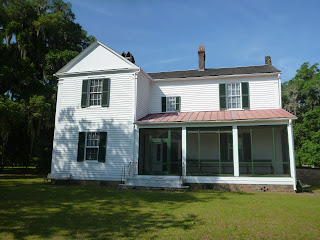It was expensive to fly from Ft Lauderdale to Asheville, especially with luggage, so I opted for a cheap deal on a rental car and took two days to drive up (770 miles). With hotel, food, and sightseeing, it ended up costing about the same as the flight. After two years away, I thought the gradual "decompression" would be best.
I drove up the coast of Florida the first day, vaguely planning to stay in Savannah overnight. Well, that was a ways off the highway and the hotels were expensive, so I opted to stay overnight near Brunswick, Georgia. I visited the Hofwyl-Broadfield Plantation the next day and learned all about antebellum rice farming. I knew nothing about this, thinking the South was all about cotton. Rice was actually a major crop until they started growing it better and cheaper in the Western U.S. Like the Biltmore House branch of the Vanderbilt's, the family turned to dairy farming to survive. Unfortunately, the last unmarried daughter died in 1973 and the plantation ended up in state hands. They did live very well in their heyday, traveling to Europe to furnish their more elaborate mansion in Charleston. At one point the plantation had 357 slaves.
 |
| Hoftwyl-Broadfield Plantation-lots of oaks and moss |
 |
| Plantation House circa early 1800's |
The next day I continued the drive through Georgia and South Carolina, stopping occasionally to look at interesting things. I finally arrived in Asheville that evening, and went to dinner with my next door neighbor, Deborah. I stayed at her house for two nights before the movers came with all my stuff that had been in storage for two years. It was really disconcerting to see all those boxes when I had been basically living out of one suitcase for so long. But having a lot of STUFF is the American way. I didn't get rid of as much as I thought I had, which was a good thing in that I didn't have to replace much.
Moving in wasn't hard, since everything pretty much went back where it had been before. My only issue was that the renters, who moved out last October after a military transfer, took all the cleaning stuff I had left, like vacuum cleaner, mops, buckets, stepstool, etc, so I did have some things to buy. The management company was very nice and replaced the vacuum cleaner and had someone come and fix the holes in the walls. I remember having to fix that kind of stuff when I was a renter so I could get my deposit back, but I guess they don't do that anymore.























































